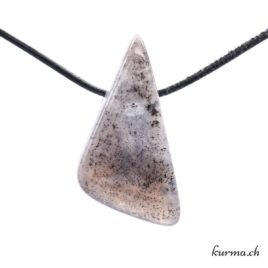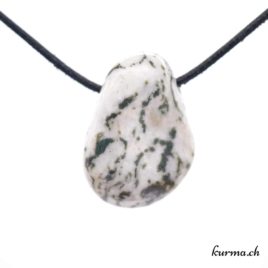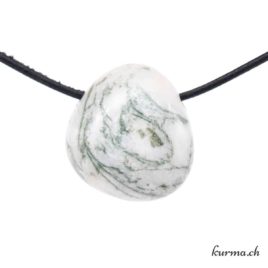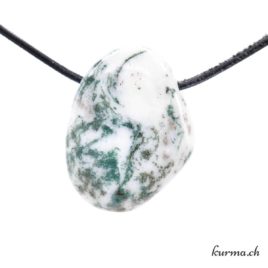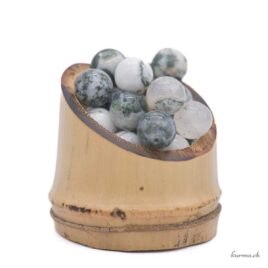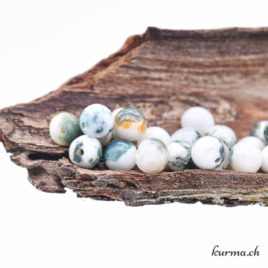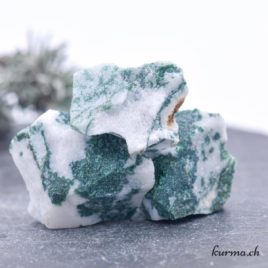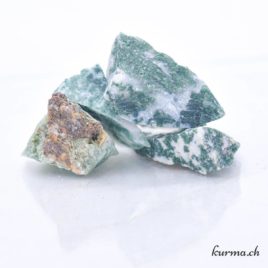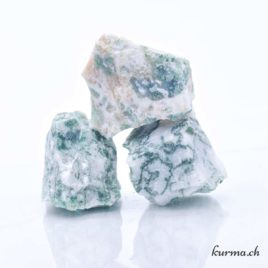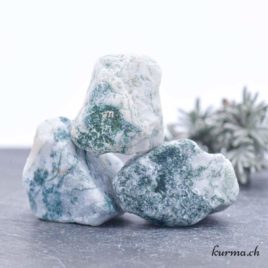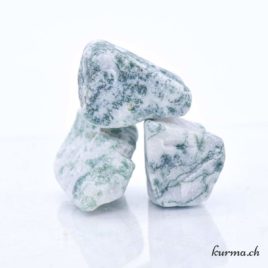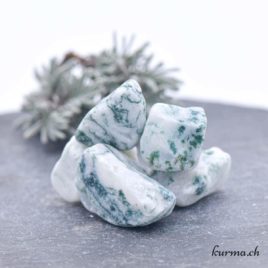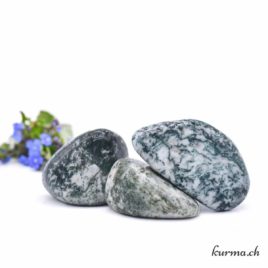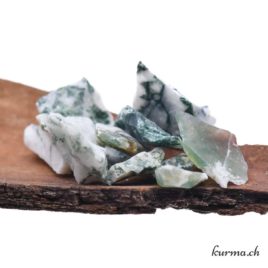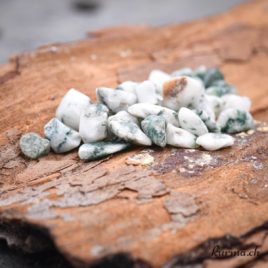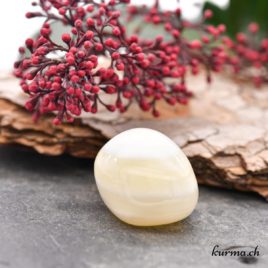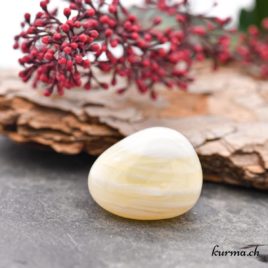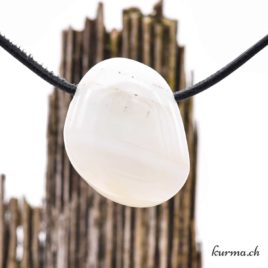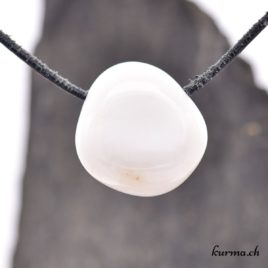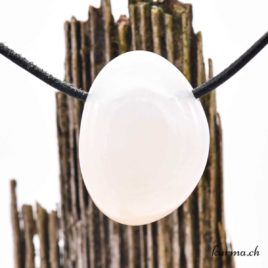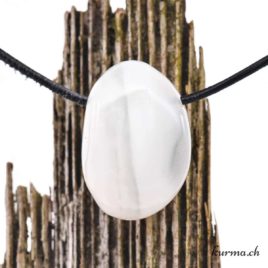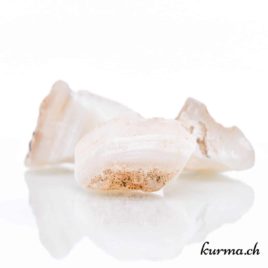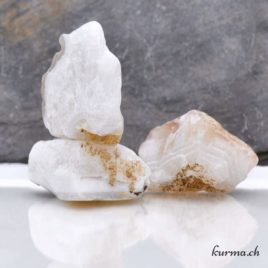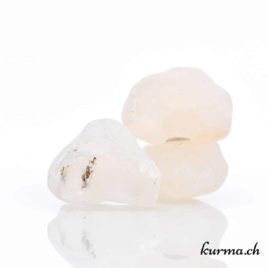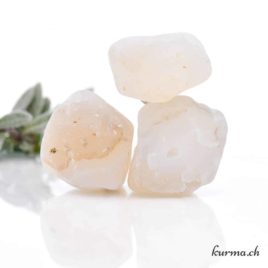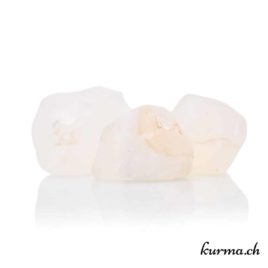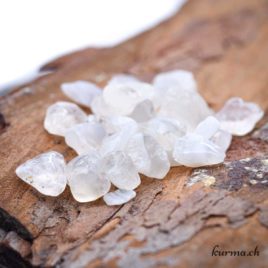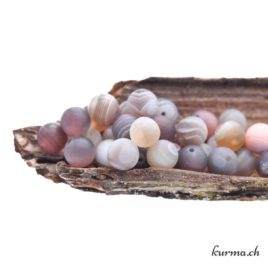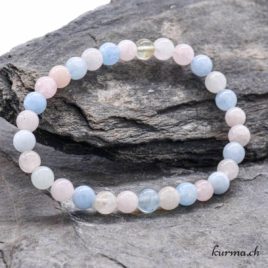Agate
Fine gemstones
Crazy Lace, carnelian reds, water agates, white agates, fire agates, dendritic agates, turitelle agates, fossil agates, orbicular agates and snakeskin agates: in a wide range of colors, with their diversity of curved patterns, agates fascinate and tell the story of Mother Earth.
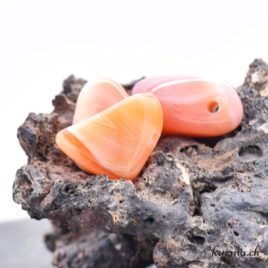
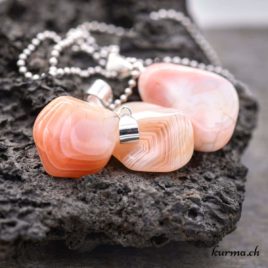


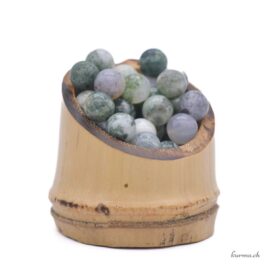


The benefits and properties of Agate in lithotherapy
What is the significance of Agate?
Agate symbolizes prosperity and longevity, and is a stone of balance, stability, solidity, support and harmony . Its feminine archetype is directly linked to the energies of Mother Earth. It has been used for thousands of years in various parts of the world to promote abundance, protection and healing.
What are the virtues of Agate?
Agate is a lullaby sung to you by the earth and water, loving arms that reassure, soothe and support you, an encouraging look that gives you the strength you need, a key word that helps you find the resources you need within yourself. Agate is a big sister, a mother, an aunt, a grandmother who welcomes you and shares her wisdom.
It brings you back down to earth, encouraging you to be pragmatic, realistic and down to earth , while taking care not to forget or denigrate your dreams. If you become scattered, if your emotions lead you into a maze with no way out, if your mind is full of stressful and invasive thoughts or if you feel lost, Agate helps you to find your center, your balance. It's a particularly comforting ally in cases of excess water, resulting in hyperemotivity.
Agate is often recommended during pregnancy for its calming properties, which are welcome in cases of great emotionality, but also for balancing the amniotic fluid.
In the case of painful premenstrual symptoms, menopausal disorders or any other hormonal disturbance resulting in excessive nervousness and sensitivity, sleep disorders, anxiety, headaches, recurring fears, sudden lack of self-confidence, etc., Agate can be of great help.
Like most soothing stones, Agate can help reduce stress, facilitate sleep and promote peaceful and restorative sleep.
What are Agate's physical properties?
On a physical level, Agate has regenerating and revitalizing properties for the body as a whole and helps regulate digestive functions.
In direct contact with the affected area, it has a soothing effect on inflammations and irritations (skin irritation, shingles, eczema, insect bites, conjunctivitis, itching...).
What are the virtues of the different Agate varieties?
True works of art of nature, Agates come in many varieties whose hues and signatures vary greatly from one to another. In lithotherapy, their more specific virtues are defined by their specific characteristics (shapes, colors, composition, patterns...)
White, transparent, crystal, black, gray, red, orange, apricot, green; or, among others, tree, rainbow or multicolored, Agate's natural colors seem to come in an infinite variety.
Crazy Lace Agate
Joyful and colorful, Crazy Lace Agate has stimulating properties that encourage enthusiasm, imagination and creativity. This "anti-morosity" stone helps you to feel better about yourself, to avoid being weighed down by heavy environmental energies and soothe emotional pain.
Applied topically, it can help soothe skin inflammation and insect bites.
Botswana Agate
Botswana Agate, with its soft curves of brown, ochre, grey and beige hues, contributes to the balance of the Yin and Yang polarities of the human being. It has soothing and reassuring qualities. It's a stone renowned for helping people to stop smoking, and for calming agoraphobia and anxiety attacks . It can also be very supportive in cases of bereavement.
It is also reputed to help release emotional blockages and promote fertility.
Physically, it stimulates the immune system, improves the circulation of energies and fluids in the body and can help with sexual dysfunctions and disorders in both men and women. Applied topically, it relieves skin irritations and helps with conjunctivitis, eye pain and fatigue.
White Agate
White Agate or Peace Agate is an ally filled with gentleness and calm, a source of soothing and comfort. It is welcome when emotions are difficult to manage and can help with breastfeeding. Placed under the pillow, it promotes peaceful sleep.
Fire Agate
Fire Agate invites you to live your desires without fear and without restricting yourself because of beliefs or blockages. It works on the 2ᵉ chakra, stimulates the libido, desires in the broadest sense, invites joie de vivre and helps to see things positively. It can help shy, reserved and introverted people to come out of their shell and dare to shine.
It symbolizes the fire of the hearth around and thanks to which life is pleasant.
On a physical level, Fire Agate stimulates digestion, can lower fever and reduce hot flushes and night sweats.
Dendritic agate
Sometimes mistakenly called "Merlinite" (Merlinite is the nickname for Gabbro), Dendritic Agate emanates protective, stabilizing and grounding energies. It promotes a connection with nature and helps women to connect with their womb. It is also an excellent stone for detoxifying the body.
Moss Agate
Moss Agate is a green or multicolored Chalcedony (red-brown-green). Water energy, the source of life and healing, is very present in this stone. With Moss Agate, you commit yourself to connecting with nature and your nature, to marvelling at the magic that surrounds you, to honouring life and the living in and around you.
Like a walk in the woods, it has soothing properties that are welcome in times of stress or mental strain.
Moss Agate soothes and helps to heal everything connected with the womb, whether physical or emotional, making it the stone of choice during preconception, pregnancy, birth, post partum, the menstrual cycle, menopause, in the event of removal of the womb or in the case of disorders or pathologies in this area of the body.
It is a friend to gardeners and growers and can be used to heal sick plants and trees.
Indian" Agate or Multicolored Moss Agate
This variety of Moss Agate promotes creativity and inspiration. It helps you come up with new ideas and set out to realize them, while keeping you firmly grounded. A positive, cheerful stone, it invites you to stay motivated and not overreact to every obstacle.
Pink moss agate
Pink Moss Agate is a perfect ally to help overcome painful memories, feelings of disgust and any resentments that prevent you from making peace with a past event.
This stone is also welcome for feeling emotionally secure.
Turitelle or fossil agate
Turitelle Agate, which contains fossilized shells more than 50 million years old, is linked to material success and can bring prosperity and abundance into your life by inviting you to connect with your own resources, potentials and natural gifts, daring to deploy them in concrete, material ways.
Tree Agate, Tree or Tree Agate
For this stone, the general virtues of Agate do not apply, as it is actually a coarse white Quartz with chlorite inclusions.
Tree Agate is the ideal ally for overcoming difficulties and challenges, especially when you feel powerless, weak, downhearted or lacking in confidence. It promotes perseverance and endurance, helps you keep the faith, not give up at the slightest obstacle and invites you to get through delicate and anxiety-provoking situations with caution and confidence.
It improves physical resistance, strengthens the immune system and stimulates the body.
Its action is slow and develops over time, so it is advisable to wear it every day on the skin over a long period.
Carnelian Agate or Red Agate
Stones called "Agates cornalines" are generally Agates that have been heated to give them deep orange-red hues. Fire energy is very present in these stones, which can help give you the strength and courage to dare to leave your comfort zone and take action.
These are energizing stones that give you a kind of boost, ideal for short-term solutions but which won't work in depth, unlike stones naturally exposed to heat during their formation.
Red Agates that have not been artificially heated have red and orange zones mixed with light hues. This is the case with Moroccan Agates, for example. These Agates allow you to find the right balance between action and inaction.
Carnelian, with its natural yellow-orange hue, is not an Agate.
Agate Sarde, Sarder or Sardoine
It is actually a brown, red and orange-colored sardony, often confused with carnelian, with which it shares many properties. Sardony is a stone with positive, joyful and warm energies, helping you to come out of your shell and take things in stride. It is also an excellent stone for calming anger and frustration.
Agate geode
An Agate geode in a room promotes peace of mind and harmony between its occupants. It's also an excellent stone to place on your bedside table to help you sleep well and let yourself be enchanted by the magic of the crystals on display.
Orbicular Agate
This Agate is used in lithotherapy to relieve organic eye disorders such as conjunctivitis or glaucoma.
Snake Agate
Snake Agate teaches you the art of transmutation and invites you to leave behind your "old skin", to shed everything you no longer need, everything that hinders you and prevents you from being authentic.
Blue Agate
Blue Agates or Agates with different shades of blue are artificially tinted Agates. They may have chromotherapy virtues, but why not choose a naturally blue stone?
There are grey Agates with very slight bluish reflections, but not strong enough to justify the virtues usually attributed to artificial blue Agate.
Blue Chalcedony is sometimes mistakenly called Blue Agate, due to confusion and a lack of mineralogical knowledge about the differences between Agates and Chalcedonies.
Fuchsia Pink Agate
As with blue Agate, this is an artificially tinted Agate. There are naturally pinkish-gray Agates, but they are very light in color and not flashy like the pink Agates sold on the market.
How to use an Agate
- For optimum use in lithotherapy, Agate is best worn in direct contact with the skin, as a pendant or bracelet, or close to the body in a pocket or bra.
- For difficult emotions, place your Agate on your heart or stomach for a moment of relaxation.
- In case of stress or overwork, take a moment to relax with your Agate placed on your forehead. You can also place it there and breathe deeply to help you fall asleep.
- In the event of skin irritation or inflammation (insect bites, eczema...) hang your Agate with a bandage directly on the affected area.
- To stimulate your creativity or enthusiasm, gaze into a crazy-lace Agate
Which stones to match an Agate with?
Agate goes very well with most stones, but depending on individual and , some combinations are more suitable than others. Here are a few ideas:
- To help stop smoking or for anxiety, you can combine Botswana Agate with Smoky Quartz.
- During pregnancy or for menstrual cycle disorders, you can wear a Moss Agate with Moonstone and Red Jasper.
- To promote fertility, wear an Agate with a Carnelian or a Hessonite Garnet and a Moonstone.
- To reduce stress, combine a light-colored Agate with a blue Chalcedony.
How to purify an Agate?
Purification and recharging of this stone
Moon, running water, waveform, fumigation, singing bowl, wind/breath, prayers...Chakras
Depending on its colorAstrological signs
AllElement
Varies according to varietyAgate in mineralogy
A member of the Quartz group and the Oxide class of minerals, Agate forms under hydrothermal conditions at temperatures ranging from 100°-200° in various layers that may be alternately composed of Quartz, Chalcedony, Jasper, Carnelian and sometimes Opal. It is these different layers that give it its famous ribbon-like appearance. Between the layers and between the quartz crystals, the presence of other elements (mainly iron, manganese, calcium and magnesium and minerals such as Hematite, Chlorite or Calcite) is frequent.
Contrary to what is stated in various books on the subject, Agate is not Chalcedony, although it may contain some. Chalcedony only forms at temperatures below 100° and can also be secondary-forming, unlike Agate, which is only primary-forming. Only moss agates and pyrite agates are chalcedonies.
Agate has a rhombohedral crystal system, but its crystals are only visible to the naked eye when formed from Quartz crystal.
Did you know?
When there's an empty space inside an Agate, it's called an Agate geode. You've probably already seen those famous ribboned Agate slices with a void in the center surrounded by Quartz crystals, this is an Agate geode slice.
When an Agate is completely full (i.e. with no void inside), it's called an Agate almond.
The main Agate deposits
There are Agate deposits all over the world, the largest being in South America, mainly in southern Brazil, but also in Mexico and Uruguay. Large deposits are also found in India, the USA, Mongolia, Russia, Botswana, Namibia and Madagascar.
In Europe, Agate gave rise to the town of Idar-oberstein, in Germany, which was built to exploit the deposits and became famous for the art of polishing and cutting fine stones. Agate is also found in the Czech Republic, Ukraine, France, Italy, Austria and Bulgaria. Today, the majority of Agate deposits in Europe are almost exhausted and mining is no longer profitable. But it is still possible to find Agate in certain regions.
Agate varieties
The diversity of its shades (from red to black, ecru, grey, beige, white, orange, salmon and brown), its composition and its patterns make Agates visually very different from one another. There are a whole host of names, often poetic, to differentiate them:
Crazy Lace Agate: Agate containing a relatively large quantity of Jasper with "crazy" designs, in a wide range of colors.
Snakeskin agate : Agate with a texture and pattern reminiscent of snakeskin.
Fire agate: Orange-colored agate with iridescent reflections due to alternating layers of iron oxide and silica, creating a "Schiller effect" (diffraction of light).
Agate turitelle: Agate formed over 50 million years ago with inclusions of fossilized freshwater snails of the genus Elimia tenera and not of the marine gastropod of the genus Turitella as its name would have us believe.
Dendritic agate: Agate with manganese dendrites.
Apricot or red agate: Apricot, orange or red agate, often artificially heated.
Flower or cloud agate: Agate named for its white areas that resemble flowers or clouds, depending on your imagination.
Banded Agate: Agate with uniform striated patterns (Botswana Agate is a Banded Agate).
Agate geode: Agate in the form of a geode (when the cavity is not completely filled).
Enhydre agate (or water agate): Agate containing water trapped in a cavity inside the stone.
Moss Agate: a secondary formation, Moss Agate is a chalcedony whose iron and magnesium silicate inclusions are reminiscent of moss.
Indian" Agate or Multicolored Moss Agate:
Moss agate (Chalcedony) in green, red, brown, beige and colorless, with Jasper and Heliotrope mixed in.
Pink moss agate:
Colorless chalcedony with orange-pink to brown patterns that form a multitude of spots of different sizes.
Tree Agate: although named as such, this is not an Agate, but a white quartz with chlorite inclusions. Be careful not to confuse it with Dendritic Agate. Tree Agate's inclusions are dark green, while Dendritic Agate's are black.
Fake" Agates and other counterfeits
Agates are very porous, which is why they are often tinted. Pink, fuchsia, blue, violet and apple-green Agates do not occur in nature and are colorless, gray or beige Agates that have been dipped in artificial dye baths.
As for apricot Agate and most red Agates and "Carnelian Agates", it's artificial heat that gives them their hue.
Agate is often dyed to be mistakenly sold under the name of another, more expensive mineral. This is how fake emeralds are "created".
The history of Agate
The 1st person to leave written traces of this mineral was the philosopher Theoprastus, 3 centuries BC. The name "Agate" comes from the river "Achates" in Sicily, where numerous deposits are found and was given to it late in history, as in antiquity Agates were considered "ribboned quartz". In the Middle Ages, all stones with ribboned patterns were called Onyx, then Jasper was wrongly named Agate. At the end of the 20th century, many Quartz stones were still considered Agateand this is still the case today with "Tree Agate"). This makes it tricky to trace the history of Agate and its various uses over the centuries through written records. For example, in Hildegarde de Binden's writings, Agate is actually Heliotrope.
Archaeological digs have revealed a little more about the history of this famous stone. We know that Agate has been used as a tool since the Upper Paleolithic, and that it was polished in the Neolithic period, and then travelled the trade routes for centuries. Agate objects from different eras have been found all over the world.
Agate has always been appreciated in jewelry and decoration for its stability and hardness, which make it easy to cut and allow for fine creations such as the famous Agate lamps, stained glass windows and vases.
Myths, beliefs and legends about Agate
In Persia, Agate was burned in rituals to ward off storms and protect crops.
Among the Celts, Agate was associated with Ceridwen, goddess of the cycle of life, death and rebirth.
In ancient times, the Romans used it as an elixir to cure snakebites and associated it with Aurora, goddess of dawn and the winds, and Bona Dea, patron goddess of women.
In Greek mythology, Agate represents Gaia, Mother Earth.
In some Muslim countries, it has been used as a powder mixed with apple juice in cases of delirium and psychic or mental disorders.
It's hard to know whether, in all these civilizations, it was Agate and not some other stone like Jasper or Quartz.
Lithotherapy
- Zodiac(s) :
- Libra, Aries, Cancer, Capricorn, Gemini, Leo, Pisces, Sagittarius, Scorpio, Taurus, Aquarius, Virgo
- Purification :
- Singing bowl, Water, Fumigation, Moon, Sun, Earth
- Physics :
- Brain, Blood circulation, Stomach, Intestines, Neurons (stimulation), Skin, Eyes
- Emotional :
- Balance
- Spiritual :
- Harmony, Sense of reality, Spirituality
- Miscellaneous :
- Pregnancy, Protection
Mineralogy
- Hardness :
- 7
- Moths scale:
- 7
- Strunz classification :
- Oxides and Hydroxides
- Crystalline system :
- Trigonal
- Chemical element :
- Si, O
- Line color :
- White
- Density :
- 2.58-2.64
- Cleavage :
- No
- Fracture:
- Uneven conchoidal
- Transparency :
- Translucent, rarely opaque
- Refringence :
- 1,530 - 1,540
- Birefringence :
- Δ=0.004; biaxial positive
- Pleochroism :
- No
- Magnetism :
- no
- Radioactivity :
- no
Not to be confused with:
*Please note! Some minerals may be toxic and must not be licked or ingested (as such or in the form of powder, elixir or stone water) or be in prolonged contact with the skin or mucous membranes.
*The information on the stones described here are general indications based on our research and experience, and are not exhaustive.
Reproduction in whole or in part of this content is prohibited. More info


